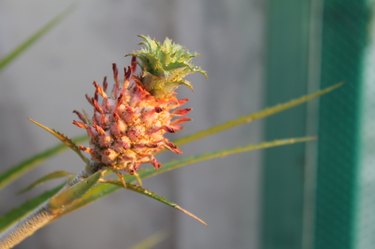
Grow a miniature pineapples, also known as dwarf pineapple (Ananas nanus), a novelty item sure to attract attention with its spiky foliage and small, palm-sized fruits. When fully mature, the fruit is 4 to 6 inches long. Miniature pineapples are a cultivar of full-size pineapple plants and thrive in USDA zones 10 through 11. Because of these limited zones, most home gardeners grow miniature pineapples indoors rather than outdoors. Miniature pineapples grown indoors as an ornamental plant need to be kept in a humid environment free of drafts and breezes.
Watering Requirements
Video of the Day
Pineapple plants tolerate drought and sandy soil so long as careful attention is placed on water and fertilizer needs. Water once every seven days unless the soil does not hold water well. During long, hot, dry periods, water the plant more frequently, especially if it is flowering or setting fruit. Mulch the soil to reduce evaporation, even if you are growing the miniature pineapple in a container. Be careful when watering because saturated soil can increase root rot.
Video of the Day
Fertilizer Considerations
Because pineapples absorb a lot of nutrition through their leaves, you can apply a high-nitrogen foliar fertilizer during all growth stages, including blossoming and fruiting periods. Apply the diluted fertilizer by misting the leaves lightly, no more than once every six to eight weeks. Too much fertilizer can burn the leaves and fruit. Wear protective gloves when applying fertilizer.
Preventing Pests
Miniature pineapple plants are especially susceptible to damage by mealybugs, small, pink-colored bugs that can damage the roots. Control mealybugs by reducing the number of ants near the plant as they encourage mealybug infestations. Mealybugs are not generally a problem for indoor pineapple plants. If a plant becomes severely infested, it is better to throw it out rather than try to salvage it.
Bearing Fruit and Mature Plant Care
Miniature pineapples, like full-sized pineapples, can take a long time to mature and produce fruit. A mature plant can produce a flower cluster in as little as eight weeks. If you are planting from slips, pups or the top of a mature miniature pineapple fruit, however, it can take more than two and-a-half years for the plant to reach maturity. Once the plant has bloomed, it will take roughly two weeks for it to set fruit. It will be another two to four months before fruits reach full maturity. Other than regular watering and fertilization, once mature, miniature pineapple plants do not require regular care. Cut off dry, dead leaves as they appear, but further pruning is not required.
Force Fruiting
Force a fully mature miniature pineapple plant to set fruit by adding products that generate acetylene or ethylene gas. Naphthaleneacetic acid needs to be diluted before using, roughly 7 milligrams per cup of water, and added to the rosette to induce flowering. Add only once as excess applications can harm the plant. You can also force a plant to blossom by wrapping it in a plastic bag with an apple and leaving it for several days in a sunny location since apples naturally release ethylene gas. This method is less reliable, however, and may not cause the pineapple plant to set fruit.
- University of Florida IFAS Extension: Pineapple Growing in the Florida Home Landscape
- Nature's Pride: Baby Pineapple
- Gardens.com: How to Grow Dwarf Pineapples
- Texas A&M: Home Fruit Production - Pineapples
- Tropical Permaculture: Growing Pineapples
- University of Hawaii: Dysmicoccus brevipes (Cockerell)